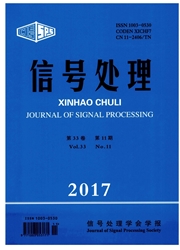

 中文摘要:
中文摘要:
心用现代时间序列分析方法,基于ARMA新息模型、白噪声估值器和舰测预报器,对带白色观测噪声的多通道ARMA信号,在线性最小方差最优信息融合准则下,提出了统一的和通用的按矩阵加权、按标量加权和按对角阵加权的多传感器信息融合Wiener滤波器,可统一处理滤波、半滑和预报问题.提出了计算局部估计误差方差和协方差的公式,它们被用于计算最优加权.同单传感器情形相比,可提高滤波精度,一个目标跟踪仿真例子说明了其有效性,且说明了三种加权融合滤波器的精度无艟著差异,因而利用按标最加权融合滤波器以轻微的精度损失提供一种快速融合估计算法,便于实时应用.
 英文摘要:
英文摘要:
Using the modern time series analysis method, based on the autoregressive moving average (ARMA) innovation model, white noise estimator and measurement predictor, under the linear minimum variance optimal fusion criterion, unified and general multisensor information fusion Wiener filters weighted by matrices, scalars and diagonal matrices are respectively presented for the multichannel ARMA signals with white observation noise. They can handle the fused filtering, smoothing and prediction problems in a unified framework. The formulas of computing variances and covariances among local estimation errors are presented, which are applied to compute the optimal weights. Compared with the single sensor case, the accuracy of the filters is improved. A simulation example for the target tracking system shows its effectiveness, and shows that the accuracy distinction for three weighted fusion filters is not obvious, so that employing the fused filter weighted by scalars provides a fast fused estimation algorithm with a slight loss of accuracy, and it is suitable for real time applications.
 同期刊论文项目
同期刊论文项目
 同项目期刊论文
同项目期刊论文
 期刊信息
期刊信息
